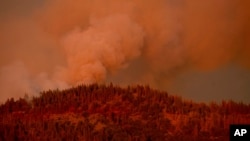A fierce California wildfire crept toward the boundary of Yosemite National Park on Tuesday as crews fought through steep, often inaccessible terrain and thick smoke to protect a string of small mountain communities in the path of the flames.
The so-called Ferguson Fire, which started on Friday night and killed a firefighter the following day, had charred nearly 19 square miles (49 square kilometers) by Tuesday afternoon and was burning just a few miles (km) outside the park.
"The fire continues to grow," fire spokeswoman Adrienne Freeman said. "There's a lot of vegetation and it's very, very dry, there's a significant amount of beetle kill (in the trees)."
"The story is, this is steep terrain," Freeman said. "You would have a difficult time walking on some of these slopes or getting people into these canyons. There are a lot of places where we simply cannot put people because it's not safe."
Making the job more difficult was an inversion layer of thick black smoke pouring off the flames and visible fore miles (km) that prevented water-dropping helicopters and fixed-wing aircraft from flying low into narrow canyons, she said.
State Route 140, a western entry point into Yosemite, remained closed by the flames. Investigators have not yet determined the cause of the conflagration.
As the blaze marched slowly east and south from its starting point at Savage Trading Post, 20 miles (32 km) southwest of the park's boundary in the Sierra Nevada mountains, fire managers warned that the communities of Jerseydale, Mariposa Pines, Clearing House and Incline could be in danger.
Firefighter Braden Varney was killed on Saturday when a bulldozer he was using to cut a fire break overturned, according to California Department of Forestry and Fire Protection.
Varney is the 10th U.S. wildland firefighter to die in the line of duty this year, according to National Interagency Fire Center data.
California has had its worst start to the fire season in a decade, with more than 220,421 acres (89,201 hectares) blackened and six major wildfires burning statewide as of Tuesday, according to the agency.
Wildfires have already burned more than 3.3 million acres (1.3 million hectares) across the United States this year, more than the year-to-date average of about 3 million acres (1.2 million hectares) over the past 10 years.
The risk of large wildfires is set to ease in much of the Southwest and Rocky Mountains due to expected summer rains, but risk levels will remain high in California through at least October, according to the agency.








